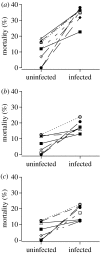Environmental influence on the genetic basis of mosquito resistance to malaria parasites
- PMID: 16777744
- PMCID: PMC1560309
- DOI: 10.1098/rspb.2006.3483
Environmental influence on the genetic basis of mosquito resistance to malaria parasites
Abstract
The genetic basis of a host's resistance to parasites has important epidemiological and evolutionary consequences. Understanding this genetic basis can be complicated by non-genetic factors, such as environmental quality, which may influence the expression of genetic resistance and profoundly alter patterns of disease and the host's response to selection. In particular, understanding the environmental influence on the genetic resistance of mosquitoes to malaria gives valuable knowledge concerning the use of malaria-resistant transgenic mosquitoes as a measure of malaria control. We made a step towards this understanding by challenging eight isofemale lines of the malaria vector Anopheles stephensi with the rodent malaria parasite Plasmodium yoelii yoelii and by feeding the mosquitoes with different concentrations of glucose. The isofemale lines differed in infection loads (the numbers of oocysts), corroborating earlier studies showing a genetic basis of resistance. In contrast, the proportion of infected mosquitoes did not differ among lines, suggesting that the genetic component underlying infection load differs from the genetic component underlying infection rate. In addition, the mean infection load and, in particular, its heritable variation in mosquitoes depended on the concentration of glucose, which suggests that the environment affects the expression and the evolution of the mosquitoes' resistance in nature. We found no evidence of genotype-by-environment interactions, i.e. the lines responded similarly to environmental variation. Overall, these results indicate that environmental variation can significantly reduce the importance of genes in determining the resistance of mosquitoes to malaria infection.
Figures


Similar articles
-
Nature or nurture in mosquito resistance to malaria?Trends Parasitol. 2007 Apr;23(4):135-8. doi: 10.1016/j.pt.2007.01.011. Epub 2007 Feb 5. Trends Parasitol. 2007. PMID: 17276733 Free PMC article.
-
Host genotype by parasite genotype interactions underlying the resistance of anopheline mosquitoes to Plasmodium falciparum.Malar J. 2005 Jan 11;4:3. doi: 10.1186/1475-2875-4-3. Malar J. 2005. PMID: 15644136 Free PMC article.
-
Phenotypic dissection of a Plasmodium-refractory strain of malaria vector Anopheles stephensi: the reduced susceptibility to P. berghei and P. yoelii.PLoS One. 2013 May 23;8(5):e63753. doi: 10.1371/journal.pone.0063753. Print 2013. PLoS One. 2013. PMID: 23717475 Free PMC article.
-
Interrupting malaria transmission by genetic manipulation of anopheline mosquitoes.J Vector Borne Dis. 2003 Sep-Dec;40(3-4):73-7. J Vector Borne Dis. 2003. PMID: 15119075 Review.
-
Malaria parasite development in mosquitoes.Annu Rev Entomol. 1998;43:519-43. doi: 10.1146/annurev.ento.43.1.519. Annu Rev Entomol. 1998. PMID: 9444756 Review.
Cited by
-
Blocking the evolution of insecticide-resistant malaria vectors with a microsporidian.Evol Appl. 2012 Apr;5(3):283-92. doi: 10.1111/j.1752-4571.2011.00219.x. Epub 2011 Nov 30. Evol Appl. 2012. PMID: 25568048 Free PMC article.
-
Prospective malaria control using entomopathogenic fungi: comparative evaluation of impact on transmission and selection for resistance.Malar J. 2012 Nov 22;11:383. doi: 10.1186/1475-2875-11-383. Malar J. 2012. PMID: 23171286 Free PMC article.
-
Interplay Between Oxytetracycline and the Homozygote kdr (L1014F) Resistance Genotype on Fecundity in Anopheles gambiae (Diptera: Culicidae) Mosquitoes.J Insect Sci. 2021 Jul 1;21(4):13. doi: 10.1093/jisesa/ieab056. J Insect Sci. 2021. PMID: 34379759 Free PMC article.
-
Epidemiological, evolutionary, and coevolutionary implications of context-dependent parasitism.Am Nat. 2011 Apr;177(4):510-21. doi: 10.1086/659002. Am Nat. 2011. PMID: 21460572 Free PMC article.
-
Alteration of plant species assemblages can decrease the transmission potential of malaria mosquitoes.J Appl Ecol. 2018 Mar;55(2):841-851. doi: 10.1111/1365-2664.13001. Epub 2017 Sep 14. J Appl Ecol. 2018. PMID: 29551835 Free PMC article.
References
-
- Alphey L, et al. Malaria control with genetically manipulated insect vectors. Science. 2002;298:119–121. doi:10.1126/science.1078278 - DOI - PubMed
-
- Anderson R.M, May R.M. Coevolution of hosts and parasites. Parasitology. 1982;85:411–426. - PubMed
-
- Aultman K.S, Beaty B.J, Walker E.D. Genetically manipulated vectors of human disease: a practical overview. Trends Parasitol. 2001;17:507–509. doi:10.1016/S1471-4922(01)02094-3 - DOI - PubMed
-
- Beaty B.J. Genetic manipulation of vectors: a potential novel approach for control of vector-borne diseases. Proc. Natl Acad. Sci. USA. 2000;97:10 295–10 297. doi:10.1073/pnas.97.19.10295 - DOI - PMC - PubMed
-
- Beier J.C. Frequent blood-feeding and restrictive sugar-feeding behavior enhance the malaria vector potential of Anopheles gambiae s.l. and An. funestus (Diptera: Culicidae) in western Kenya. J. Med. Entomol. 1996;33:613–618. - PubMed
MeSH terms
Substances
LinkOut - more resources
Full Text Sources

